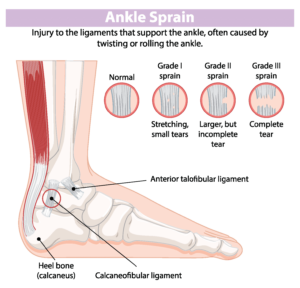The great outdoors offers individuals the opportunity to improve their fitness while enjoying the beautiful surroundings that nature has provided. Sometimes, however, those beautiful surroundings can offer unintended consequences – like twisting or spraining your ankle. It’s happened to almost everyone at some point in time – you didn’t see that hole underneath those leaves and now you have a grade 2 ankle sprain preventing you from enjoying the activity you love. And if you turn your ankle while hiking more than a few times you are even more susceptible to yet another ankle injury, and even worse, chronic ankle instability.
Even though foot orienteering is dramatically different from hiking, the way you’re injuring your ankle is usually similar between the two. Most often, participants are walking or running on uneven terrain when they accidentally turn their ankle excessively inward causing the ligaments on the outside of the ankle to stretch or tear. This stretching/tearing of the ankle ligaments is what results in an ankle injury that is measured on a scale of 1-3 to diagnose severity.

Grades of ankle sprains
RECOVERING FROM A HIKING ANKLE INJURY
After seeking medical attention to evaluate and treat your ankle injury, there will come a time when you’re healthy enough to resume normal activity. Unfortunately, once ankle ligaments have been stretched during an injury, they do not bounce back to their original state causing the ankle joint to become loose and unstable. This can potentially begin a cycle of injury where each time you twist your ankle the ligament stretches more and more until you develop chronic ankle issues.
So, how do you stop this cycle of ankle injuries? Better shoes? Taping your ankles? Medication? There are numerous solutions available, but one of the best ways to prevent further ankle injuries, or lessen the severity of an ankle injury, is to seek out a good ankle brace. When it comes to researching ankle braces it may seem like most are geared for high intensity team sports such as football, volleyball or basketball – but which ankle brace is the best for hiking?
The best ankle braces for hiking require the following characteristics:
Comfort – It seems obvious that you would want a comfortable ankle brace if you’re trekking through hills and valleys for extended periods of time. When it comes to any type of brace, comfort is directly related to how the product is designed and what materials it’s made of. In the case of ankle braces, the most comfortable designs are the ones that take the shape of, and move with, your ankle joint.
Cheaper designs may be made of fabric, while advanced ankle braces designed for both comfort and support will use modern materials such as the molded Performathane® technology used in Ultra Ankle® braces. Performathane® is a thermoplastic material that uses body heat to form a custom-fit to the ankle and is known for its flexible, yet durable, properties that will never break or crack.
Long-Lasting Ankle Support – Because of the constant movement of the ankle joint, all ankle braces loosen a bit the longer you wear them. Some ankle braces, however, loosen significantly quicker than others due to the way they are designed and the materials they are made of. Any ankle brace made of cloth that laces up or wraps around your ankle will lose support rapidly because they restrict natural up and down ankle movement. Unlike lace-up ankle braces, hinged braces move with natural ankle range of motion keeping the components of the brace, like the straps, firmly in place maintaining long-lasting ankle support.
Durability – Just like your other gear, you need to consider how the outdoor elements will impact your ankle brace. Rain, mud and sweat have a way of accelerating the deterioration of all materials, especially fabrics. Not only will the material deteriorate and tear faster than usual, ankle braces made of fabric will also absorb bacteria that often results in a foul odor.
What about hiking shoes/boots? – Shoes/boots play a vital role in how an ankle brace fits and feels. Some ankle braces might fit better in a low top trail shoe while a hiking boot may require a different type of ankle brace which fits better in a taller boot. Our Hiking Page explains all the details of trail shoes versus hiking boots and which ankle brace works best with each.
If you’re a hiker and you have a history of twisting your ankle during activity, then wearing a preventative ankle brace might be right for you. Our athletic trainers are always available to answer any specific questions you might have so please send us a message!